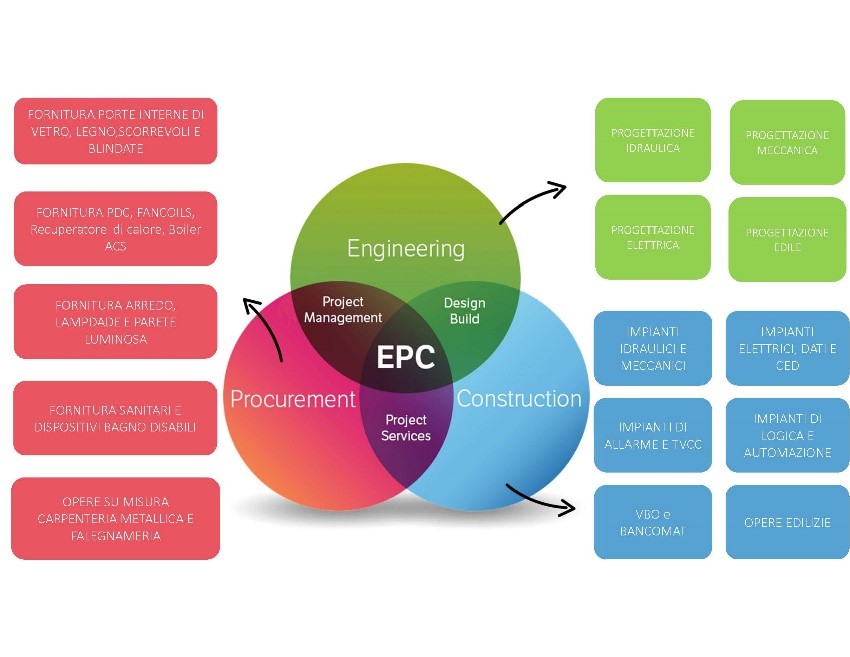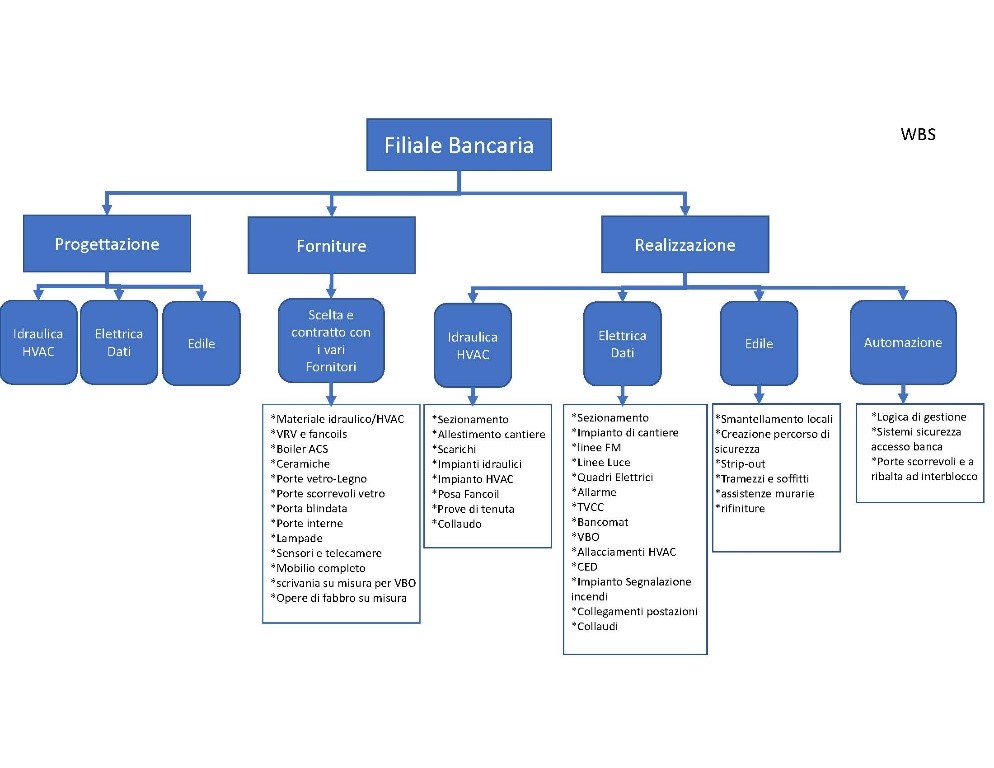AUTHOR: Marco Moretto
TUTORS: Prof. G. Franchi
MASTER: Master in “Project and Contract Management in construction works” a.a 2019/2020
L’ elaborato di tesi vuole analizzare un progetto da me seguito in qualità di Project Manager di una società di general Contractor, relativo al completo rifacimento di una banca, tramite un contratto di EPC.
Il contratto siglato a seguito della gara d’appalto prevedeva una soluzione di tipo chiavi in mano, nella quale le opere del capitolato comprendevano i seguenti ambiti: edile, meccanico, idraulico, elettrico, dati, opere su misura di falegnameria e carpenteria metallica, sicurezza-antieffrazione e tvcc, locale CED, locale accesso Bancomat con triplo interblocco, mobilio e finiture interne. In questo progetto è stato inoltre chiesto di creare ed implementare un servizio di virtual banking di nuova generazione (VBO) con sistemi di connessioni dati remote, monitor e diverse telecamere per permettere ai clienti di entrare nel locale in completa sicurezza, per effettuare qualunque tipo di operazione bancaria senza la presenza fisica di un operatore sul posto, mettendosi virtualmente in contatto con un dipendente della banca dedicato.
Una delle problematiche preliminari di questo lavoro, consisteva nel mantenere attivi i servizi bancari durante l’intera vita del cantiere è stato quindi fatto un trasloco provvisorio in un’area contigua all’area del cantiere, sempre di pertinenza della banca, per mantenere attivi durante tutto il periodo dei lavori sia l’accesso all’area caveau che a quella del bancomat. Per tali motivi è stato necessario in fase preliminare ideare delle strategie e delle opere esecutive particolari, al fine di garantire la massima sicurezza durante tutto il cantiere senza arrecare disagi alla clientela della banca. L’edificio risalente agli inizi del Novecento aveva cambiato più volte destinazione d’uso con le relative opere di ristrutturazione: inizialmente adibito a cascina, poi a ristorante, in seguito divenne un hotel fino a giungere all’ultima destinazione d’uso come banca. In tutti questi interventi di trasformazione, della struttura e soprattutto della parte impiantistica, erano rimasti segni di opere precedenti non più necessarie emerse in fase di realizzazione dello strip out, di cui però non vi era alcuna traccia documentale. A causa di questa mancanza di documentazione tecnica (strutturale e impiantistica) in corso d’opera sono insorte delle problematiche che hanno comportato delle modifiche organizzative e progettuali, che potevano pregiudicare i tempi di consegna previsti nel contratto.
L’analisi critica del contratto di gara ha evidenziato tutte le carenze e possibili problematiche legate allo stesso, alcune delle quali sono poi insorte durante le opere di realizzazione. In questo progetto si è appurato come sia fondamentale per un PM la conoscenza e la valutazione dei contratti. Tale analisi se fosse stata fatta a monte della siglatura del contratto, avrebbe permesso l’eliminazione di molte problematiche riscontrate durante il progetto, quali ad esempio quelle legate alla definizione di procedure e tempistiche per le varianti, al riconoscimento di eventuali EOT e di indennizzi.
In seguito alla consegna del cantiere si è ricevuto un Claims da parte di un vicino della banca, per delle problematiche legate al rumore prodotto da una delle Pompe di Calore che è stato risolto evitando di incorrere in procedure legali.
Sarebbe stato opportuno inoltre analizzare il progetto seguendo le tecniche e gli schemi presentati nell’elaborato di tesi quali WBS, OBS, RACI e aver strutturato il cronoprogramma con software specifici in grado di poter effettuare delle analisi utili, quali il CPM, il PERT e permettere di avere maggior controllo sul float e verificare in maniera rapida l’incidenza delle varianti o degli imprevisti, valutandone l’impatto anche sul percorso critico.
FOR INTERNATIONAL STUDENTS
The scope of this abstract is to focus on a very articulated project that I’ve managed as Project Manager, about the complete reconstruction of a Bank, involving an EPC Contract, between a very famous Italian Bank and a General Contractor. The contract signed, following the tender, included the following areas: construction, HVAC, plumbing, electrical, data, tailor-made joinery and metal carpentry works, burglar-proof and CCTV security, data center, ATM access room with triple interlocking, furniture and interior finishes. It was requested to create and implement a next generation virtual banking service (VBO) with remote data connection systems, monitors and various cameras to allow customers to enter in this room in a complete safe way and get virtually in touch with a dedicated bank employee, to carry out any type of banking transaction without the physical presence of an operator on site. The first problem of this work was to keep the banking services active throughout the entire life of the construction site. First of all, we had to temporary move the bank in a pertaining area of the bank close to the site, keeping both access to the vault area and to the ATM service throughout the entire period of the works. For these reasons it was necessary in the preliminary phase to devise particular strategies and works in order to ensure to the bank’s customers the maximum safety throughout the construction site. Therefore, the timing imposed by the contract was very stringent.
The building dating back to the early twentieth century had changed its intended use several times with the related renovation works: this building was first of all a farmhouse, then a restaurant, then a hotel until it reached the last intended use as a bank. In all of these transformational interventions in the structure and above all in the plant engineering part, there were traces of previous works that were no longer necessary, of which however there was no documentary trace, which emerged during the construction phase during the strip out. The lack of the technical documentation (structural and plant engineering) during the work led to organizational and design changes, which could affect the delivery times provided in the contract. The scope of this abstract is to focus on a very articulated project that I’ve managed as Project Manager, about the complete reconstruction of a Bank, involving an EPC Contract, between a very famous Italian Bank and a General Contractor. The contract signed, following the tender, included the following areas: construction, HVAC, plumbing, electrical, data, tailor-made joinery and metal carpentry works, burglar-proof and CCTV security, data center, ATM access room with triple interlocking, furniture and interior finishes. It was requested to create and implement a next generation virtual banking service (VBO) with remote data connection systems, monitors and various cameras to allow customers to enter in this room in a complete safe way and get virtually in touch with a dedicated bank employee, to carry out any type of banking transaction without the physical presence of an operator on site. The first problem of this work was to keep the banking services active throughout the entire life of the construction site. First of all, we had to temporary move the bank in a pertaining area of the bank close to the site, keeping both access to the vault area and to the ATM service throughout the entire period of the works. For these reasons it was necessary in the preliminary phase to devise particular strategies and works in order to ensure to the bank’s customers the maximum safety throughout the construction site. Therefore, the timing imposed by the contract was very stringent.
The building dating back to the early twentieth century had changed its intended use several times with the related renovation works: this building was first of all a farmhouse, then a restaurant, then a hotel until it reached the last intended use as a bank. In all of these transformational interventions in the structure and above all in the plant engineering part, there were traces of previous works that were no longer necessary, of which however there was no documentary trace, which emerged during the construction phase during the strip out. The lack of the technical documentation (structural and plant engineering) during the work led to organizational and design changes, which could affect the delivery times provided in the contract.
The critical analysis of the tender contract has highlighted all the shortcomings and possible problems related to it, some of which then arose during the construction works. In this project it was found that the knowledge and evaluation of contracts is fundamental for a PM. If this analysis had been made upstream of the signing of the contract, it would have allowed the elimination of many problems encountered during the project, such as those related to the definition of procedure and timing for the variations, requests for EOT and compensation. Following the taking over of the construction site, a complaint was received from a neighbor of the bank, for problems related to the noise produced by a heat pump, which was solved without incurring in legal procedures. It would have been appropriate to analyze the project based on the techniques and schemes presented in the thesis work such as WBS, OBS, RACI and to have structured the time schedule with specific software capable of carrying out useful analyzes, such as CPM, PERT and allows the PM to have greater control over the float and to perform a quick check the incidence of variations or unforeseen events, also evaluating their impact on the critical path.


